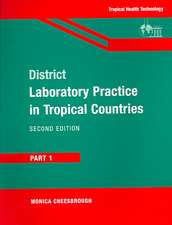Mouse Models for Drug Discovery: Methods and Protocols: Methods in Molecular Biology, cartea 1438
Editat de Gabriele Proetzel, Michael V. Wilesen Limba Engleză Hardback – 6 mai 2016
Practicaland fully updated, Mouse Models for DrugDiscovery: Methods and Protocols, Second Edition serves to equip the reader with an extensive overviewof techniques to utilize the many possibilities of mice in the drug developmentprocess.
| Toate formatele și edițiile | Preț | Express |
|---|---|---|
| Paperback (2) | 897.81 lei 6-8 săpt. | |
| Springer – 26 mai 2018 | 897.81 lei 6-8 săpt. | |
| Humana Press Inc. – 23 aug 2016 | 1020.95 lei 6-8 săpt. | |
| Hardback (2) | 724.00 lei 6-8 săpt. | |
| Humana Press Inc. – 17 dec 2009 | 724.00 lei 6-8 săpt. | |
| Springer – 6 mai 2016 | 726.48 lei 6-8 săpt. |
Din seria Methods in Molecular Biology
- 9%
 Preț: 791.59 lei
Preț: 791.59 lei - 23%
 Preț: 598.56 lei
Preț: 598.56 lei -
 Preț: 496.79 lei
Preț: 496.79 lei - 20%
 Preț: 882.95 lei
Preț: 882.95 lei -
 Preț: 252.04 lei
Preț: 252.04 lei - 5%
 Preț: 717.33 lei
Preț: 717.33 lei - 5%
 Preț: 719.11 lei
Preț: 719.11 lei - 5%
 Preț: 728.83 lei
Preț: 728.83 lei - 5%
 Preț: 734.57 lei
Preț: 734.57 lei - 15%
 Preț: 652.28 lei
Preț: 652.28 lei - 18%
 Preț: 1008.02 lei
Preț: 1008.02 lei - 5%
 Preț: 722.21 lei
Preț: 722.21 lei - 18%
 Preț: 898.77 lei
Preț: 898.77 lei - 15%
 Preț: 653.42 lei
Preț: 653.42 lei - 15%
 Preț: 643.10 lei
Preț: 643.10 lei - 18%
 Preț: 1390.83 lei
Preț: 1390.83 lei - 5%
 Preț: 730.10 lei
Preț: 730.10 lei - 20%
 Preț: 821.63 lei
Preț: 821.63 lei - 18%
 Preț: 955.89 lei
Preț: 955.89 lei - 15%
 Preț: 649.37 lei
Preț: 649.37 lei - 5%
 Preț: 725.98 lei
Preț: 725.98 lei - 18%
 Preț: 968.31 lei
Preț: 968.31 lei - 5%
 Preț: 720.93 lei
Preț: 720.93 lei -
 Preț: 392.58 lei
Preț: 392.58 lei - 5%
 Preț: 733.70 lei
Preț: 733.70 lei - 18%
 Preț: 946.42 lei
Preț: 946.42 lei - 23%
 Preț: 860.21 lei
Preț: 860.21 lei - 15%
 Preț: 641.66 lei
Preț: 641.66 lei - 5%
 Preț: 1037.69 lei
Preț: 1037.69 lei - 23%
 Preț: 883.85 lei
Preț: 883.85 lei -
 Preț: 792.16 lei
Preț: 792.16 lei -
 Preț: 423.62 lei
Preț: 423.62 lei - 5%
 Preț: 425.91 lei
Preț: 425.91 lei -
 Preț: 592.20 lei
Preț: 592.20 lei - 5%
 Preț: 345.62 lei
Preț: 345.62 lei - 19%
 Preț: 491.88 lei
Preț: 491.88 lei - 5%
 Preț: 1038.84 lei
Preț: 1038.84 lei - 5%
 Preț: 524.15 lei
Preț: 524.15 lei - 18%
 Preț: 2086.44 lei
Preț: 2086.44 lei - 5%
 Preț: 1277.30 lei
Preț: 1277.30 lei -
 Preț: 789.93 lei
Preț: 789.93 lei - 5%
 Preț: 1339.10 lei
Preț: 1339.10 lei - 18%
 Preț: 1366.79 lei
Preț: 1366.79 lei - 5%
 Preț: 752.66 lei
Preț: 752.66 lei - 5%
 Preț: 374.89 lei
Preț: 374.89 lei - 18%
 Preț: 1372.05 lei
Preț: 1372.05 lei - 18%
 Preț: 1110.57 lei
Preț: 1110.57 lei - 18%
 Preț: 1384.47 lei
Preț: 1384.47 lei - 18%
 Preț: 1105.93 lei
Preț: 1105.93 lei - 18%
 Preț: 949.98 lei
Preț: 949.98 lei
Preț: 726.48 lei
Preț vechi: 764.72 lei
-5% Nou
Puncte Express: 1090
Preț estimativ în valută:
139.11€ • 143.49$ • 115.29£
139.11€ • 143.49$ • 115.29£
Carte tipărită la comandă
Livrare economică 20 februarie-06 martie
Preluare comenzi: 021 569.72.76
Specificații
ISBN-13: 9781493936595
ISBN-10: 149393659X
Pagini: 346
Ilustrații: XI, 436 p. 63 illus., 37 illus. in color.
Dimensiuni: 178 x 254 x 25 mm
Greutate: 0.99 kg
Ediția:2nd ed. 2016
Editura: Springer
Colecția Humana
Seria Methods in Molecular Biology
Locul publicării:New York, NY, United States
ISBN-10: 149393659X
Pagini: 346
Ilustrații: XI, 436 p. 63 illus., 37 illus. in color.
Dimensiuni: 178 x 254 x 25 mm
Greutate: 0.99 kg
Ediția:2nd ed. 2016
Editura: Springer
Colecția Humana
Seria Methods in Molecular Biology
Locul publicării:New York, NY, United States
Cuprins
Genetically Defined Strains in DrugDevelopment and Toxicity Testing.- Simple, Efficient CRISPR-Cas9Mediated Gene Editing in Mice: Strategies and Methods.- Mouse Sperm Cryopreservation andRecovery of Genetically Modified Mice.- Generation of Immunodeficient Mice Bearing Human Immune Systems by the Engraftmentof Hematopoietic Stem Cells.- Generation of Human Liver ChimericMice for the Study of Human Hepatotropic Pathogens.- Human FcRn Transgenic Mice forPharmacokinetic Evaluation of Therapeutic Antibodies.- A Humanized Mouse Model to StudyHuman Albumin and Albumin Conjugates Pharmacokinetics.- Germ-Free Mice Model for StudyingHost-Microbial Interactions.- Bridging Mice to Men: Using HLATransgenic Mice to Enhance the Future Prediction and Prevention of AutoimmuneType 1 Diabetes in Humans.- Mouse Models of Type 2 DiabetesMellitus in Drug Discovery.- Cholesterol Absorption andMetabolism.- Skin Diseases in Laboratory Mice:Approaches to Drug Target Identification and Efficacy Screening.- Chronic Myeloid Leukemia (CML) MouseModel in Translational Research.- Murine Model for Colitis-AssociatedCancer of the Colon.- Mouse Models for StudyingDepression-Like States and Antidepressant Drugs.- Experimental Models of Anxiety forDrug Discovery and Brain Research.- Repetitive Behavioral Assessmentsfor Compound Screening in Mouse Models of Autism Spectrum Disorders.- Better Utilization of Mouse Modelsof Neurodegenerative Diseases in Preclinical Studies: From the Bench to theClinic.- Neuromuscular Disease Models andAnalysis.- Brightfield Imaging and Optical Coherence Tomography of the MousePosterior Eye.- MouseModels as Tools to Identify Genetic Pathways for Retinal Degeneration, asExemplified by Leber's Congenital Amaurosis.
Textul de pe ultima copertă
With genetic engineering, systems explored in this book now exist allowing for the simple, efficient, and near universally precise genetic manipulation directly in any organism, including the mouse. Herein, these models are applied to a wide field of disease areas, including diabetes, cardiovascular disease, skin disorders, cancer, neurodegenerative and neuromuscular diseases, retinal disorders, as well as various behavioral models. Written for the highly successful Methods in Molecular Biology series, chapters include introductions to their respective topics, lists of the necessary materials and reagents, step-by-step, readily reproducible laboratory protocols, and tips on troubleshooting and avoiding known pitfalls.
Practical and fully updated, Mouse Models for Drug Discovery: Methods and Protocols, Second Edition serves to equip the reader with an extensive overview of techniques to utilize the many possibilities of mice in the drug development process.
Caracteristici
Incudes fully updated cutting-edge methods and protocols for using mouse models in drug research Provides step-by-step detail essential for reproducible results Contains key notes and implementation advice from the experts Includes supplementary material: sn.pub/extras
Recenzii
From the reviews:
“This book details methods for drug delivery and common measurements using mouse and disease models. … useful to those who are interested in using mouse models in their research, particularly for those diseases discussed in the book. … many of the methods will be useful across diverse areas of research. … useful for researchers using mice to study diseases, particularly if they want to use new procedures. The descriptions of how to administer drugs using various methods are presented well. … the book is helpful.” (Karen M. Kassel, Doody’s Review Service, July, 2010)
“This book details methods for drug delivery and common measurements using mouse and disease models. … useful to those who are interested in using mouse models in their research, particularly for those diseases discussed in the book. … many of the methods will be useful across diverse areas of research. … useful for researchers using mice to study diseases, particularly if they want to use new procedures. The descriptions of how to administer drugs using various methods are presented well. … the book is helpful.” (Karen M. Kassel, Doody’s Review Service, July, 2010)






